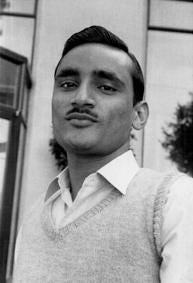Choudhri Mohammed Naim (3 June 1936 – 9 July 2025) taught me how to read and write the Nastaʿlīq script. It frustrated him no end that I came to him in 1990 with no idea how to write the Urdu language, particularly given that he highly respected my grandfather – Baini Prashad – who had translated a number of works from Arabic, Turkish, and Farsi into English. It tells you a lot about India, he would say to me, that Baini Prashad’s grandson cannot write Farsi. Well, he couldn’t, but he could not have wanted a better teacher than C. M. Naim. Although, I had my own back at him: how could C. M. Naim have an office on the way to the toilet, I would say cheekily?
I was a clumsy reader and writer of Urdu and still am – lessons at Urdu Academy in Nizamuddin not helping me at all. Naimsaheb, as everyone called him, was an anchor to texts and ideas that had been put into retreat by the 1980s. Born in Barabanki and raised in the qasbas of the United Provinces during the tumult of the anti-colonial period and into the new nation, Naimsaheb left for studies at the University of California (Berkeley) in September 1957 – a very young man, distraught by Partition, who would then make his life in the United States.}
We became fast friends because when we met, he had just returned from a highly impactful time in Palestine (where he had travelled with Rashid Khalidi), and Naimsaheb was pleased to know that I was active in the Palestine solidarity movement – it remained a bond between us for years afterwards. I have a million stories about Naimsaheb, several of them include Aijaz Ahmad, but those will have to wait for a later date.
The photograph is from his trip to Palestine in 1989. In the picture are his University of Chicago colleagues the Palestinian historian Rashid Khalidi, the African historian Ralph Austen (1937-2024), and Janet Gunn, with Bassam Shakaa (1930-2019, the mayor of Nablus, who lost both his legs in a car bombing by the Jewish Underground in June 1980).
الوداع






Interesting. Very interesting. 👌